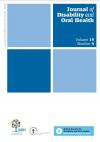Journal of Disability and Oral Health

- Cover Date:
- December 2018
- Vol:
- 19
- Issue:
- 4
Laser doppler flowmetry for vitality testing dental pulp: potential use in special care patients unable to communicate
Manouchehri and Kerr: Laser doppler flowmetry
Laser doppler flowmetry for vitality testing dental
pulp: potential use in special care patients unable
to communicate
S Manouchehri1 and B Kerr2
1. Dental Core Trainee in Oral and Maxillofacial Surgery;
2. Consultant in Special Care Dentistry, Department of Sedation and Special Care Dentistry, Guy’s Hospital, London, UK
Abstract
Laser Doppler Flowmetry (LDF) is a “non-invasive electro-optical technique†(Karayilmaz and Kirzioglu, 2011) which
can be used to assess the vitality of the dental pulp and thus aid in dental diagnosis and treatment planning. This
method is an accurate and reproducible alternative to conventional methods of assessing the pulp which involve
assessing the innervation of dental tissues by means of electrical or thermal stimuli. Patients most likely to benefit
from this technique are those who lack the ability to respond to conventional methods of vitality testing such as
patients with Autism, Cognitive Impairment (CI) or Learning Disability (LD). Principles of LDF and its application to
Special Care Dentistry (SCD) are discussed.
Key words: Laser Doppler Flowmetry,
dental pulp, Special Care Dentistry
Date Manuscript Received: 07/02/2018
Date Manuscript Accepted: 02/07/2018
Doi: 10.443/JDOH/Manouchehri_04
Introduction
Laser doppler flowmetry (LDF)
Assessment of the status of the pulp is critical in facilitating
accurate dental diagnosis and treatment. Commonly used
methods include use of thermal or electrical stimuli such as
use of ethyl chloride and an Electric Pulp Tester (EPT)
although these methods are subjective and rely heavily on
patient co-operation and operator interpretation of response
(Karayilmaz and Kirzioglu, 2011).
As well as requiring a level of cognitive understanding
and the ability to communicate this, conventional methods
of assessing the pulp by means of noxious electrical or
thermal stimuli can be an unpleasant experience for the
patient and therefore may produce inaccurate results. This
poses a challenge for the clinician, particularly in cases
where patients cannot communicate such as patients with
learning disability (LD) or cognitive impairment (CI).
An alternative method for assessing pulp vitality would be
to assess the perfusion of the pulp i.e. a vital pulp would be
well perfused as opposed to a necrotic pulp. One such
method is use of Laser Doppler Flowmetry (LDF) which
assesses Pulpal Blood Flow (PBF).
LDF is a “non-invasive electro-optical techniqueâ€
(Karayilmaz and Kirzioglu, 2011) which could become a useful
diagnostic tool in the assessment of pulpal vitality. LDF allows
the clinician to objectively determine the presence or absence
of pulpal blood flow (PBF) and thus assess pulp vitality. This is
achieved by applying the Doppler principle (Fredriksson, Fors
and Johansson, 2007). Beams of infrared or near infrared light
are transmitted through the tissues via the optical fibres of a
specific probe held against the tooth surface (Fredriksson, Fors
and Johansson, 2007). Moving red blood cells scatter these
lights as well as causing frequency shifts whilst static dental
tissues scatter these lights but they remain unshifted
(Fredriksson, Fors and Johansson, 2007). As a result, a voltage
is produced and is then converted to arbitrary units of pulpal
perfusion (1PU=10mV) (Karayilmaz and Kirzioglu, 2011). The
readings of LDF are pulsatile in nature and seem to correlate
with cardiac output rhythm as recorded on an ECG
(Musselwhite et al., 1997). This suggests that LDF can
accurately record PBF which is not dissimilar to the blood flow
around the human body as supplied by the heart.
166 | Journal of Disability and Oral Health (2018) | 19/4
- Article Price
- £15.00
- Institution Article Price
- £
- Page Start
- 12
- Page End
- 15
- Authors
- B Kerr, S Manouchehri
Articles from this issue
- Title
- Pg. Start
- Pg. End
- Laser doppler flowmetry for vitality testing dental pulp: potential use in special care patients unable to communicate
- 12
- 15
- Original research Understanding oral health challenges for children and young people with autistic spectrum conditions
- 16
- 20
